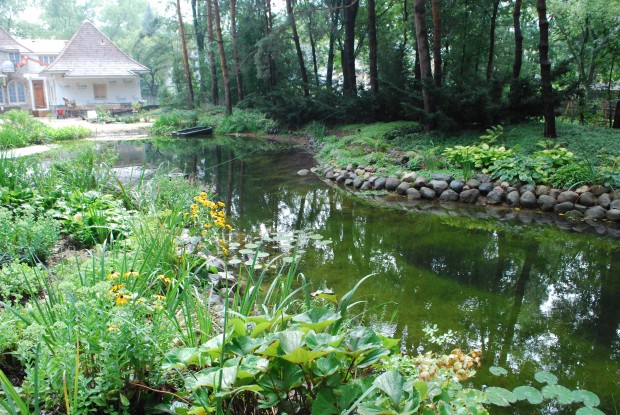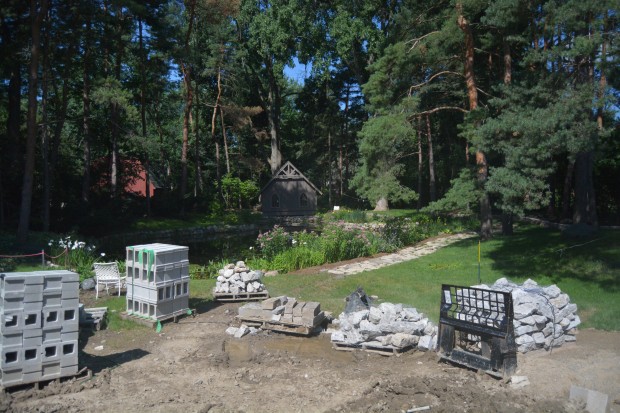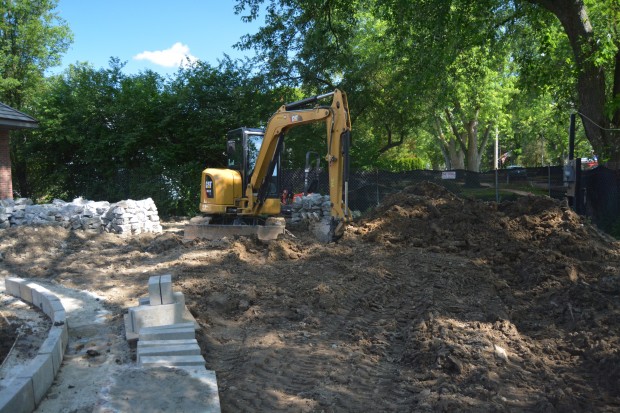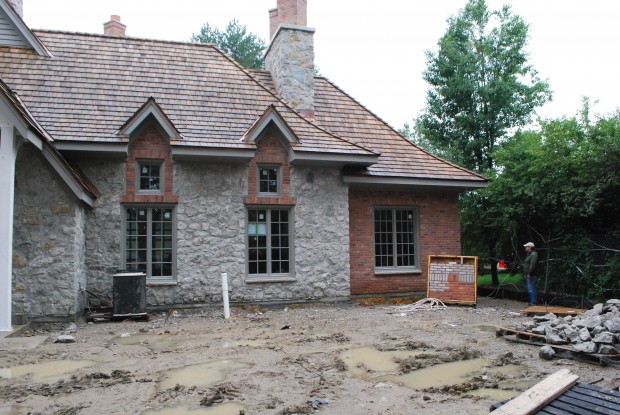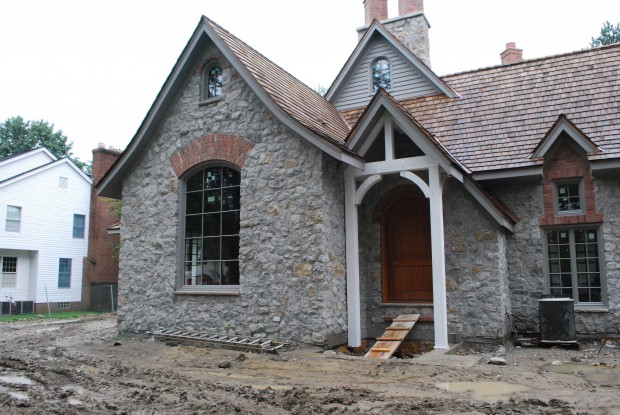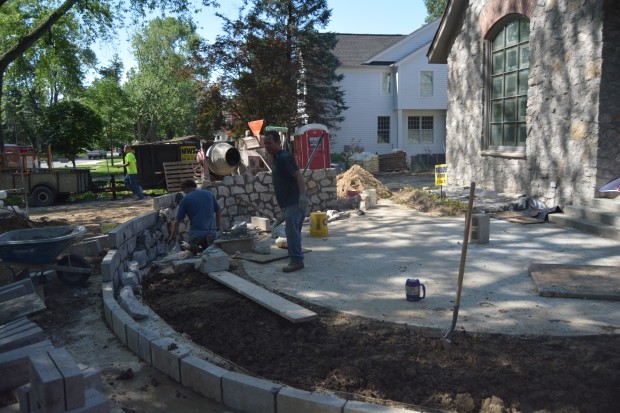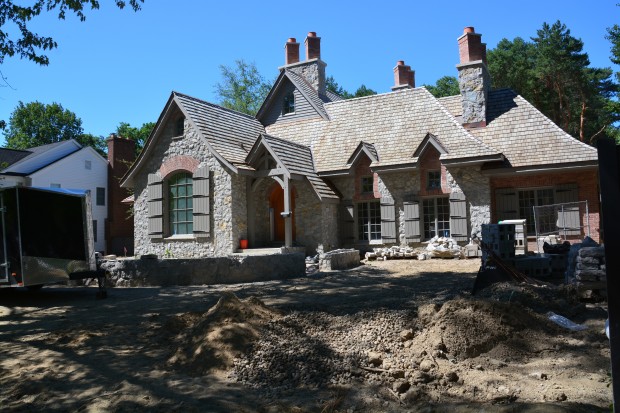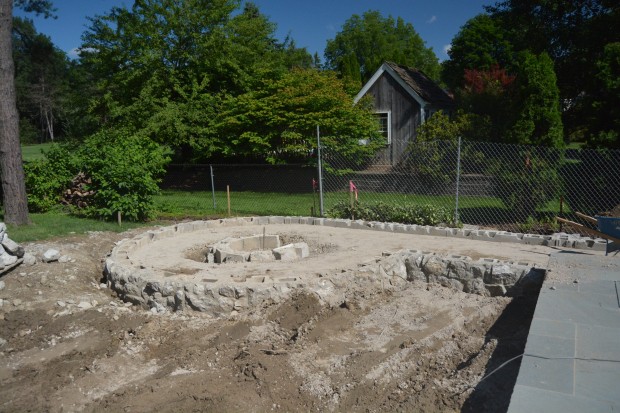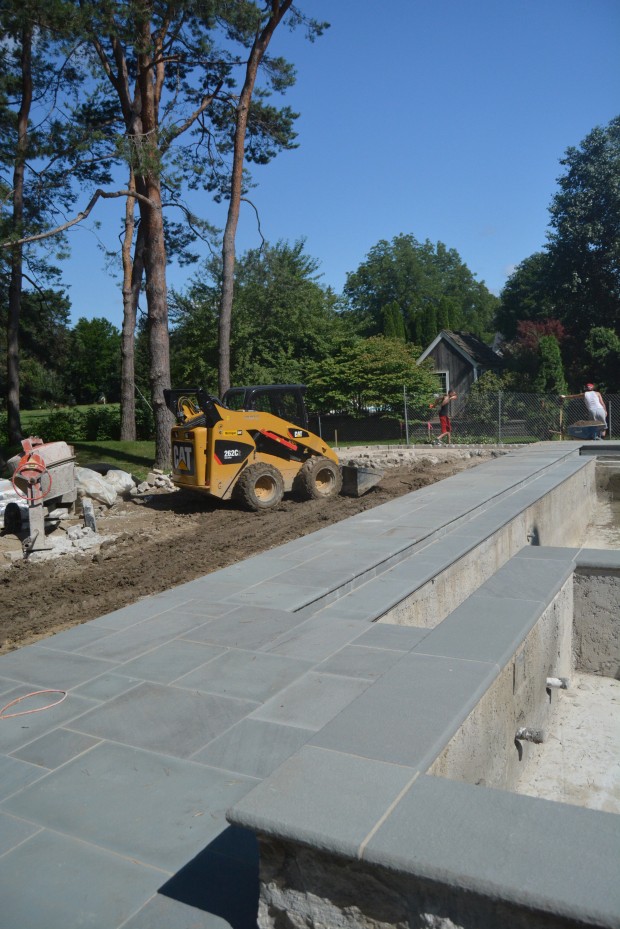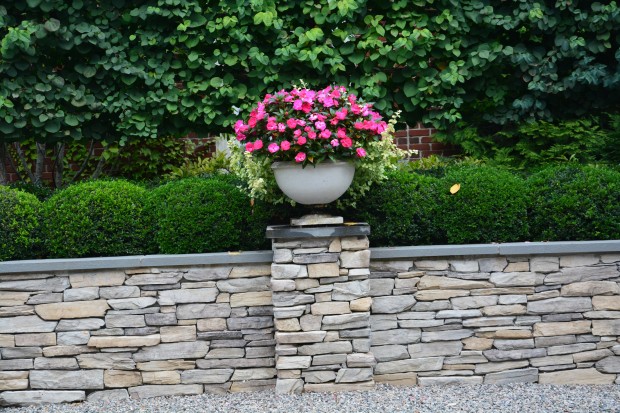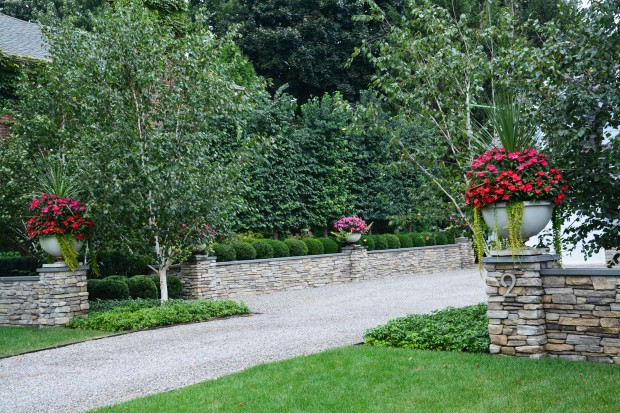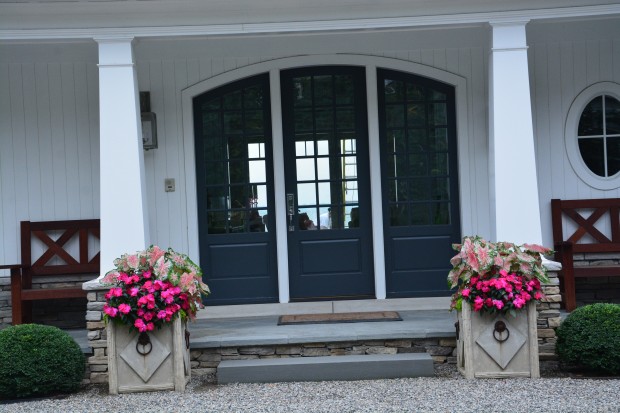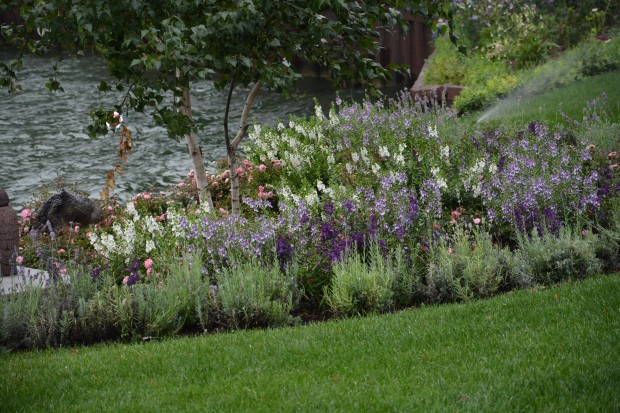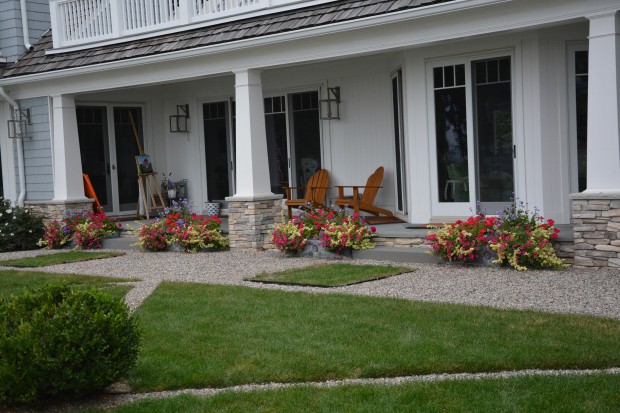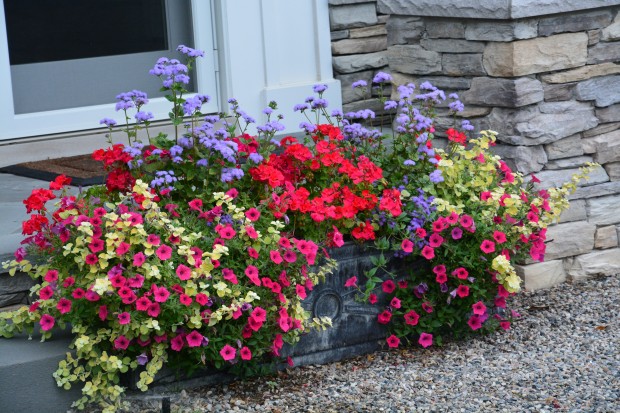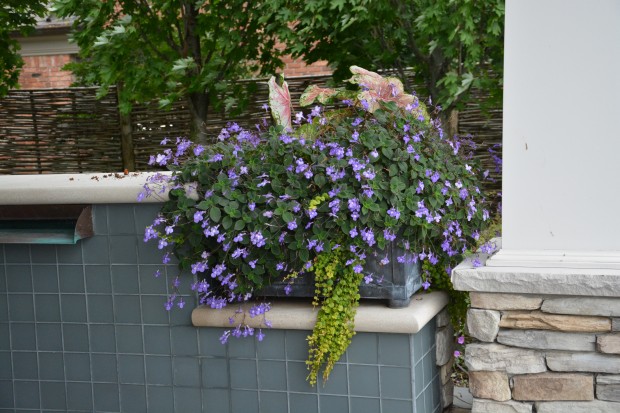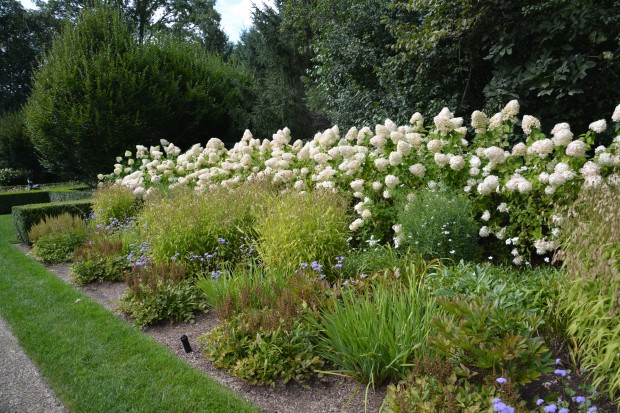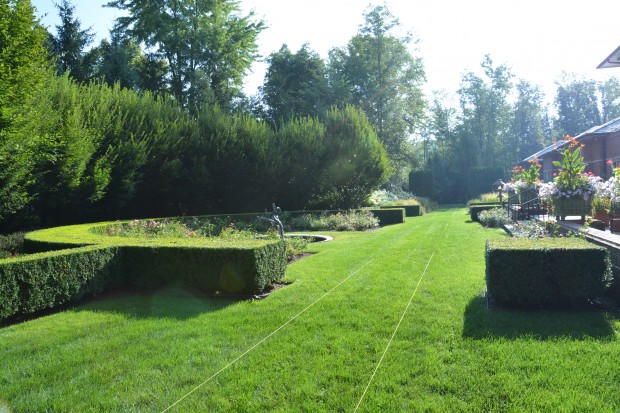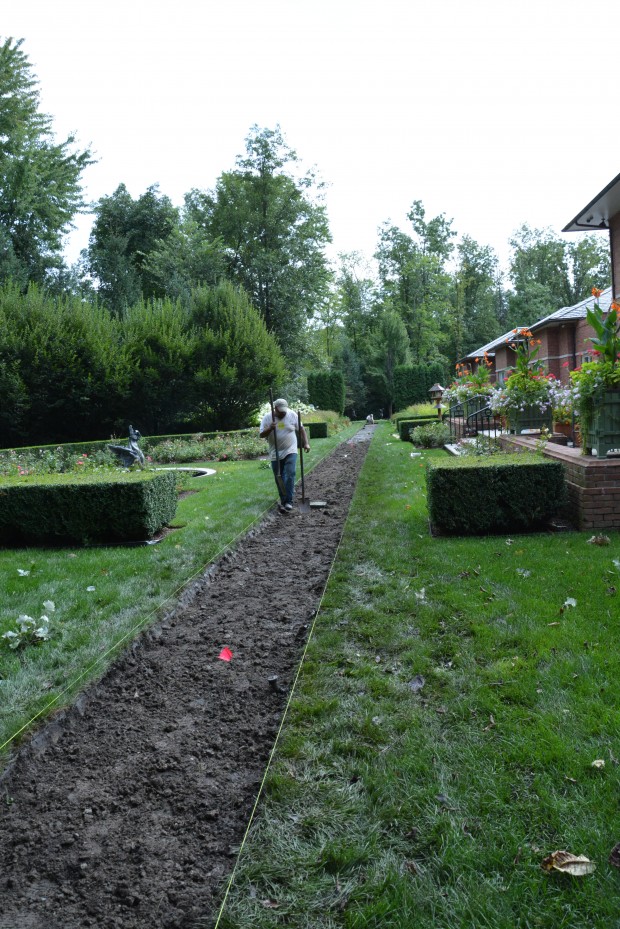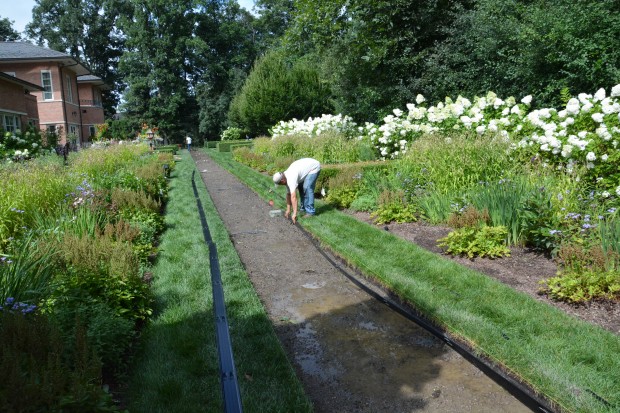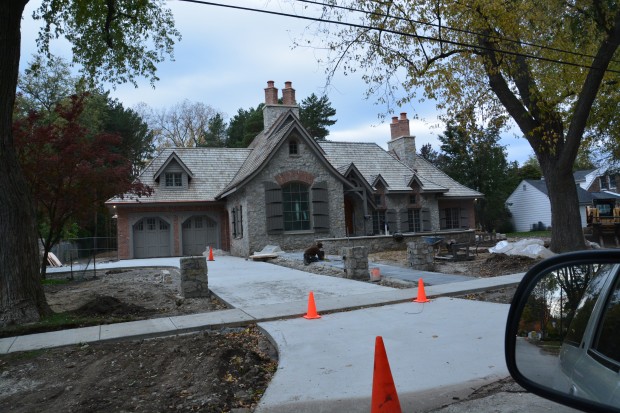 By the final months of 2013, the sidewalk was nearing completion, the driveway base got poured, the curving front courtyard wall and pillars for the cast iron fence were complete. The iron work-yet to come. At least we were past the point of contractors parking in the front yard. It is next to impossible to convey to an electrician that the weight of his vehicle damages the structure and drainage capacity of soil. We just breathe a sigh of relief when they are finished and gone. The ground that has been driven over for years had become much like a parking lot, only paved with dirt. To make matters worse, our area is noted for its heavy clay soil. This project involved lots of hand digging to reintroduce oxygen to the soil, and the addition of compost to leaven the clay.
By the final months of 2013, the sidewalk was nearing completion, the driveway base got poured, the curving front courtyard wall and pillars for the cast iron fence were complete. The iron work-yet to come. At least we were past the point of contractors parking in the front yard. It is next to impossible to convey to an electrician that the weight of his vehicle damages the structure and drainage capacity of soil. We just breathe a sigh of relief when they are finished and gone. The ground that has been driven over for years had become much like a parking lot, only paved with dirt. To make matters worse, our area is noted for its heavy clay soil. This project involved lots of hand digging to reintroduce oxygen to the soil, and the addition of compost to leaven the clay.
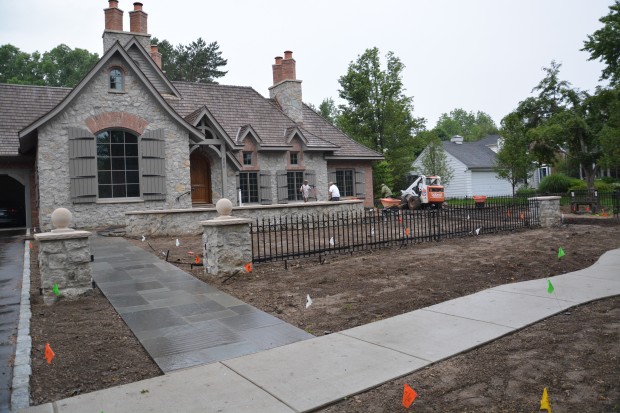 The soil would need grading to the levels established by the house, drive, walk and terraces. This part of the landscape installation takes the most time. Once the soil is graded, a good rain will tell if there are any non-draining areas. Once plants are in the ground, they cover over any water that may be sitting on top of the soil. It is vastly easier to spot drainage problems in this stage. Eventually the iron fencing got installed, all but one panel. We needed access to the yard with a machine, and tools. The new blue stone sidewalk was for foot traffic only-and certainly not our feet.
The soil would need grading to the levels established by the house, drive, walk and terraces. This part of the landscape installation takes the most time. Once the soil is graded, a good rain will tell if there are any non-draining areas. Once plants are in the ground, they cover over any water that may be sitting on top of the soil. It is vastly easier to spot drainage problems in this stage. Eventually the iron fencing got installed, all but one panel. We needed access to the yard with a machine, and tools. The new blue stone sidewalk was for foot traffic only-and certainly not our feet.
 It is such a relief to get to the dirt stage. I like moving soil around, marking bed lines, and preparing beds to be planted. It is a sure sign of progress. On the subject of soil for woody plants, I am a member of the do not disturb camp. Years ago I would dig holes for every tree and shrub at least 3 times bigger than the size of the root ball. Once the shrub was planted, I would back fill the hole with soil concocted in the wheelbarrow. Topsoil, sand peat moss, compost, and worm castings were blended to make the soil of my dreams.
It is such a relief to get to the dirt stage. I like moving soil around, marking bed lines, and preparing beds to be planted. It is a sure sign of progress. On the subject of soil for woody plants, I am a member of the do not disturb camp. Years ago I would dig holes for every tree and shrub at least 3 times bigger than the size of the root ball. Once the shrub was planted, I would back fill the hole with soil concocted in the wheelbarrow. Topsoil, sand peat moss, compost, and worm castings were blended to make the soil of my dreams.
 Years later, a study from Michigan State disputed the wisdom of planting a tree in soil which was anything other than existing soil. Once the roots reached the end of the heavenly soil, the shock of the native soil could set the tree back for years. This only makes sense. A root ball needs to be set on firm ground-not new soil. This makes sense too. New soil is full of air. A tree that sinks below grade is a tree that will have problems. I choose plants that thrive not only in my hardiness zone, but in my soil. I caution clients who insist on having rhododendrons. They look great in full bloom at nurseries here in the spring, but I am quite sure none of those plants are Michigan grown. Though there are neighborhoods nearby with giant and thriving rhododendrons, that is not the norm.
Years later, a study from Michigan State disputed the wisdom of planting a tree in soil which was anything other than existing soil. Once the roots reached the end of the heavenly soil, the shock of the native soil could set the tree back for years. This only makes sense. A root ball needs to be set on firm ground-not new soil. This makes sense too. New soil is full of air. A tree that sinks below grade is a tree that will have problems. I choose plants that thrive not only in my hardiness zone, but in my soil. I caution clients who insist on having rhododendrons. They look great in full bloom at nurseries here in the spring, but I am quite sure none of those plants are Michigan grown. Though there are neighborhoods nearby with giant and thriving rhododendrons, that is not the norm.
 Last fall, we did purchase 8 large katsura espaliers for this project. When it became clear that there would be no movement on the landscape until this spring, we heeled those trees in at our nursery yard. We did plant them while we were grading and preparing beds. The root balls measured almost 40 inches across, meaning the trees were very heavy, and difficult to handle. I was interested to make the move before they began to leaf out, in the interest of less stress for both the trees and my crew over the transplant. This particular spot on the lot line was well above the grade of the neighboring property. A very low retaining wall, not visible in this picture, was built to keep the soil in place. The large solid balls of the katsuras proved to be a help maintaining the grade we needed.
Last fall, we did purchase 8 large katsura espaliers for this project. When it became clear that there would be no movement on the landscape until this spring, we heeled those trees in at our nursery yard. We did plant them while we were grading and preparing beds. The root balls measured almost 40 inches across, meaning the trees were very heavy, and difficult to handle. I was interested to make the move before they began to leaf out, in the interest of less stress for both the trees and my crew over the transplant. This particular spot on the lot line was well above the grade of the neighboring property. A very low retaining wall, not visible in this picture, was built to keep the soil in place. The large solid balls of the katsuras proved to be a help maintaining the grade we needed.
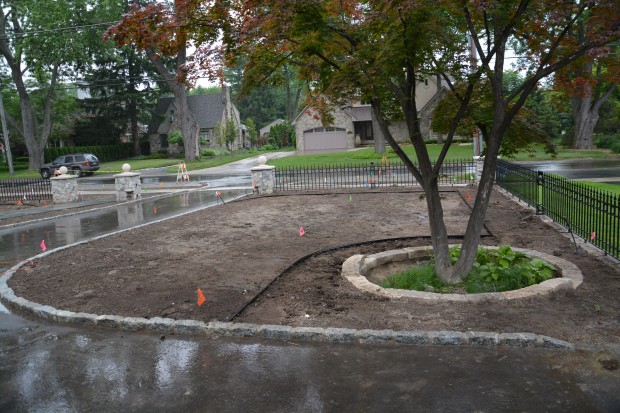 Once the grade was established, all of the beds to be landscaped were edged in aluminum edger strip. This insures the integrity of the bed lines, and more importantly, it keeps the lawn grass out of the borders. A landscape within reasonable maintenance limits is a landscape every client appreciates. Edging beds is not only a skill, it is a whomping lot of work. A landscape bed with sloppy edges has a sloppy look. Crisp edges and mowed grass can make the most weed stricken garden look better. An existing Japanese maple that had survived the construction was protected from the grade change with a stone well.
Once the grade was established, all of the beds to be landscaped were edged in aluminum edger strip. This insures the integrity of the bed lines, and more importantly, it keeps the lawn grass out of the borders. A landscape within reasonable maintenance limits is a landscape every client appreciates. Edging beds is not only a skill, it is a whomping lot of work. A landscape bed with sloppy edges has a sloppy look. Crisp edges and mowed grass can make the most weed stricken garden look better. An existing Japanese maple that had survived the construction was protected from the grade change with a stone well.
 Areas which would be planted with perennial material are treated differently than those for trees and shrubs. A tree which is properly sited for zone, existing soil and light will, given a little care, take hold and thrive. There will be no deadheading, or dividing. With any luck, that thriving will go on for many years. If you count out horseradish, and some of the big growing grasses, most perennials do not put down roots that deep. But I do like 16 inches of decent well drained soil, if I can get it. A garden grown on sand is easily to establish, and the devil to keep year after year. The gardens to be planted on this heavy clay soil may take some doing. More than likely, we will loose some plants. But once established, and top dressed every year with compost or ground hardwood bark, a garden in heavy soil will have a long and happy life.
Areas which would be planted with perennial material are treated differently than those for trees and shrubs. A tree which is properly sited for zone, existing soil and light will, given a little care, take hold and thrive. There will be no deadheading, or dividing. With any luck, that thriving will go on for many years. If you count out horseradish, and some of the big growing grasses, most perennials do not put down roots that deep. But I do like 16 inches of decent well drained soil, if I can get it. A garden grown on sand is easily to establish, and the devil to keep year after year. The gardens to be planted on this heavy clay soil may take some doing. More than likely, we will loose some plants. But once established, and top dressed every year with compost or ground hardwood bark, a garden in heavy soil will have a long and happy life.
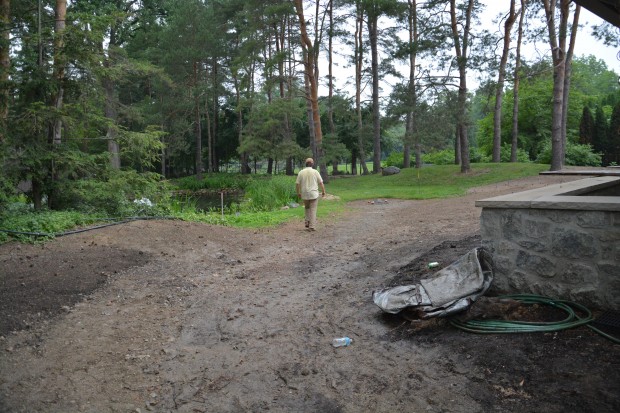 Establishing the proper grade in the back yard took some finesse. Of course, matching the new grade to the old would be ideal. But the new house and walks have created drainage issues which never existed before. The most likely spot for water to pool is dead ahead. The contractor had run several large storm drains to exactly this spot. The last part of the grading would be to lower the grade from the stone walk yet to come to the pond. The big idea here was to plan for surface water to have an unobstructed path to the pond. What could be better than keeping the level of the pond up with rain water?
Establishing the proper grade in the back yard took some finesse. Of course, matching the new grade to the old would be ideal. But the new house and walks have created drainage issues which never existed before. The most likely spot for water to pool is dead ahead. The contractor had run several large storm drains to exactly this spot. The last part of the grading would be to lower the grade from the stone walk yet to come to the pond. The big idea here was to plan for surface water to have an unobstructed path to the pond. What could be better than keeping the level of the pond up with rain water?

